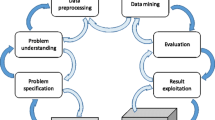Abstract
From the perspective of military intelligence work, the rise and widespread use of the network has opened up new horizons for intelligence acquisition, but the continuous increase in the amount of data in the network has made traditional intelligence analysis stretched. Therefore, enriching and developing military intelligence analysis methods have certain practical significance to make up for the shortcomings in current intelligence analysis. The traditional military intelligence analysis method cannot realize the in-depth mining and analysis of the network Shanghai information, obtain the deep intelligence knowledge required by the military, introduce the data mining technology into the military intelligence analysis and construct the network military intelligence analysis based on data mining model. The semantic analysis-based intelligence analysis algorithm in this model has certain superiority compared with the traditional association analysis, which can effectively improve the analysis efficiency and accuracy of military intelligence.







Similar content being viewed by others
References
Hong H, Shi Y (2018) Fast deconvolution for motion blur along the blurring paths. Can J Electr Comput Eng 40(4):266–274
Huang Z, Zhang Y, Li Q (2018) Spatially adaptive denoising for X-ray cardiovascular angiogram images. Biomed Signal Process Control 40:131–139
He YB, Zeng YJ, Chen HX (2018) Research on improved edge extraction algorithm of rectangular piece. Int J Modern Phys C 29(1):1850007
Yan X, Zhu Z, Wu Q (2018) Intelligent inversion method for pre-stack seismic big data based on MapReduce. Comput Geosci 110:81–89
Yan X, Gong W, Wu Q (2017) Contaminant source identification of water distribution networks using cultural algorithm. Concurr Comput Pract Exp 29(4), Document number: UNSP e4230
Wu Q, Wang L, Zhu Z (2017) Research of pre-stack AVO elastic parameter inversion problem based on hybrid genetic algorithm. Clust Comput J Netw Softw Tools Appl 20(4):3173–3183
Wu Q, Zhu Z, Yan X (2017) Research on the parameter inversion problem of prestack seismic data based on improved differential evolution algorithm. Clust Comput J Netw Softw Tools Appl 20(4):2881–2890
Yu Z, Zhou H, Li C (2017) Fast non-rigid image feature matching for agricultural UAV via probabilistic inference with regularization techniques. Comput Electron Agric 143:79–89
Yan X, Song T, Wu Q (2017) An improved cultural algorithm and its application in image matching. Multimed Tools Appl 76(13):14951–14968
Wang F, Zhang QL (2016) Systemic estimation of dam overtopping probability: bayesian networks approach. J Infrastruct Syst 23(2), Document number: 04016037
Yu R, Ding C, Zhang D (2017) All-optical control of weak-light transport and Fano-like resonance using control-probe technique in a quantum-dot-pillar microcavity system. J Appl Phys 121(14), Document number:144303
Wang Y, Yan C, Jianzhong Y (2017) Tool path generation algorithm based on covariant field theory and cost functional optimization and its applications in blade machining. Int J Adv Manuf Technol 90(1–4):927–943
Yan X, Liu H, Zhu Z (2017) Hybrid genetic algorithm for engineering design problems. Clust Comput J Netw Softw Tools Appl 20(1):263–275
Chen D, Zhang YD, Wei W (2017) Efficient vulnerability detection based on an optimized rule-checking static analysis technique. Front Inf Technol Electron Eng 18(3):332–345
Ma Y, Wang J, Xu H (2017) Robust image feature matching via progressive sparse spatial consensus. IEEE Access 5:24568–24579
Lu T, Xiong Z, Zhang Y (2017) Robust face super-resolution via locality-constrained low-rank representation. IEEE Access 5:13103–13117
Zhang S, Tian X, Xiong C (2017) Fast implementation for the singular value and eigenvalue decomposition based on FPGA. Chin J Electron 26(1):132–136
Wu Q, Liu H, Yan X (2016) Multi-label classification algorithm research based on swarm intelligence. Clust Comput J Netw Softw Tools Appl 19(4):2075–2085
Wang H, Sun Z, Chen S (2016) A novel real-time method for moving vehicle detection. J Internet Technol 17(7):1501–1509
Hong H, Hua X, Zhang X (2016) Multi-frame real image restoration based on double loops with alternative maximum likelihood estimation. SIViP 10(8):1489–1495
Xia P (2016) Haptics for product design and manufacturing simulation. IEEE Trans Haptics 9(3):358–375
Yan X, Wu Q, Sheng VS (2016) A double weighted Naive Bayes with niching cultural algorithm for multi-label classification. Int J Pattern Recognit Artif Intell 30(6), Document number:1650013
Liao H, Lu S, Wang D (2016) Tied factor analysis for unconstrained face pose classification. OPTIK 127(23):11553–11566
Yang X, Wang QA (2017) 2D numerical study of polar active liquid crystal flows in a cavity. Comput Fluids 155(SI):33–49
Yu S, Song J, Hua X (2017) Poissonian image deblurring method by non-local total variation and framelet regularization constraint. Comput Electr Eng 62:319–329
Hua X, Liu J (2015) A novel fast algorithm for the pseudo Winger-Ville distribution. J Commun Technol Electron 60(11):1238–1247
Zheng Y, Wang Y, Wong DSH (2015) A time series model coefficients monitoring approach for controlled processes. Chem Eng Res Des 100:228–236
Wu S, Mingqing W, Zou Yuntao (2018) Bidirectional cognitive computing method supported by cloud technology. Cogn Syst Res 52:615–621
Shaofei W, Mingqing W, Maozhu J et al (2019) Uniform L1 stability of the inelastic Boltzmann equation with large external force for hard potentials. Discrete Contin Dyn Syst Ser S 12(4–5):1005–1013
Shaofei W (2019) Nonlinear information data mining based on time series for fractional differential operators. Chaos 29, Article Number 013114
Shaofei W (2015) A traffic motion object extraction algorithm. Int J Bifurc Chaos 25(14), Article Number 1540039
Wu S, Mingqing W, Yuntao Z (2018) Research on internet information mining based on agent algorithm. Future Gener Comput Syst 86:598–602
Qishou K, Wu S, Mingqing W, Yuntao Z (2018) Evaluation of developer efficiency based on improved DEA model. Wireless Pers Commun 12(4):3843–3849
Wu S, Mingqing W, Yuntao Z (2018) Sewage information monitoring system based on wireless sensor. Desalination Water Treatment 121:73–83
Acknowledgements
This work was supported by the Natural Science Foundation of Hubei Province of China under Grant No. 2018CFB681.
Author information
Authors and Affiliations
Corresponding author
Additional information
Publisher's Note
Springer Nature remains neutral with regard to jurisdictional claims in published maps and institutional affiliations.
Rights and permissions
About this article
Cite this article
Wu, S., Liu, J. & Liu, L. Modeling method of internet public information data mining based on probabilistic topic model. J Supercomput 75, 5882–5897 (2019). https://doi.org/10.1007/s11227-019-02885-8
Published:
Issue Date:
DOI: https://doi.org/10.1007/s11227-019-02885-8




